Have you ever found yourself in a large, unfamiliar environment, desperately searching for the right direction? As customers drive through communities looking for show homes or key features, it can be stressful to find the right way. New developments might not be available in Google Maps or other GPS systems, so it’s important to put together effective wayfinding signage that will take your customers to where you need them to go. Wayfinding is the art and science of helping people navigate through complex spaces and environments – ensuring they reach their desired destinations with ease. In this blog, we’ll explore the ins and outs of wayfinding from its definition to the key components of effective wayfinding signage.
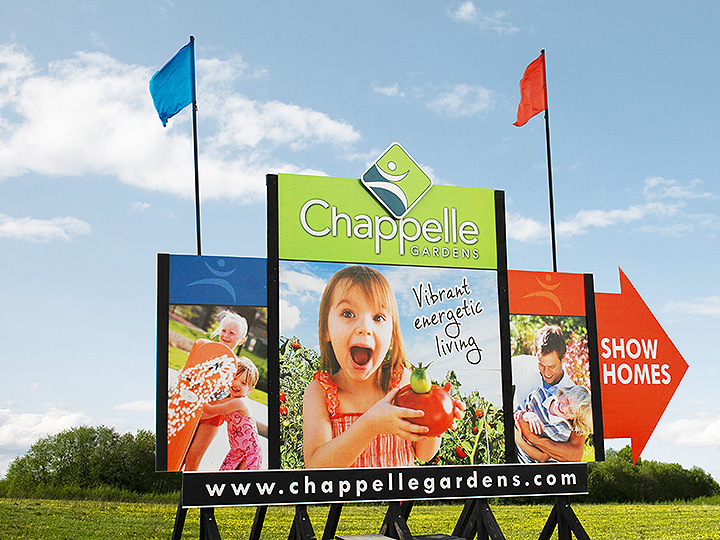
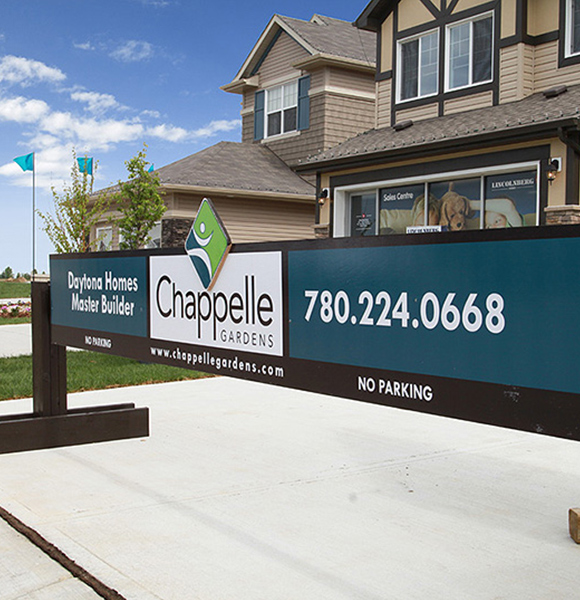
What is Wayfinding?
Wayfinding is more than just providing directions – it’s about creating a cohesive system that guides individuals intuitively through your community and minimizes confusion. Wayfinding in communities is a combination of signage and flags that reflect your brand, values, and direct people through multiple ways to select spots.
Wayfinding Signage
Wayfinding signage is a critical component of any wayfinding program. These are the physical signposts, maps, symbols, and labels strategically placed throughout a space to guide people to their destinations. Typically, directional signs in wayfinding are 4 foot by 8 foot and placed along roads within and outside your community. Effective wayfinding signage is designed with clarity, consistency, and simplicity in mind.
Designing Effective Wayfinding Signage
Effective wayfinding signage needs to ensure that the creative is readable from a distance, doesn’t confuse audiences, and organized in an efficient manner. Here are a few tips for designing effective wayfinding signage.
Clear and Concise Messaging
Signage should communicate information quickly and clearly. Use simple language and well-recognized symbols to convey directions and points of interest. Avoid adding unnecessary messaging or mixing messages within a sign. A sign should have a single call to action, so if you’re wanting someone to turn left, don’t also ask them to visit your website to learn more about the community.
Consistent Branding
Maintain consistency in design elements, colors, and fonts across all signage. This fosters familiarity and makes the navigation process smoother. When you pair your wayfinding signage to your community branding it also ensures that your ads, website, and other marketing efforts will be more memorable.
Placement is Key
Ensure that your wayfinding is strategically positioned at decision points and potential areas of confusion, such as intersections, important roadways, and along sections where there aren’t any turning points for a while.
Provide a Clear Information Hierarchy
Prioritize information based on relevance. Important destinations or the directional arrows should be prominent and central, while secondary information can be placed in a less conspicuous manner. Secondary information includes logos, taglines, or contact information.
Consider the Environment
Tailor the design of signage to match the aesthetics of the space while ensuring visibility. For example, if you’re placing signs in a largely wooded area with plenty of bushes and trees, you may not want your sign’s background colour to be green.
Building a Successful Wayfinding Program
Building a successful wayfinding program requires a lot of time and effort. You want to ensure you have a clear understanding of how people will visit your community and find their way around. In order to build a successful wayfinding program, here are some key components to consider.
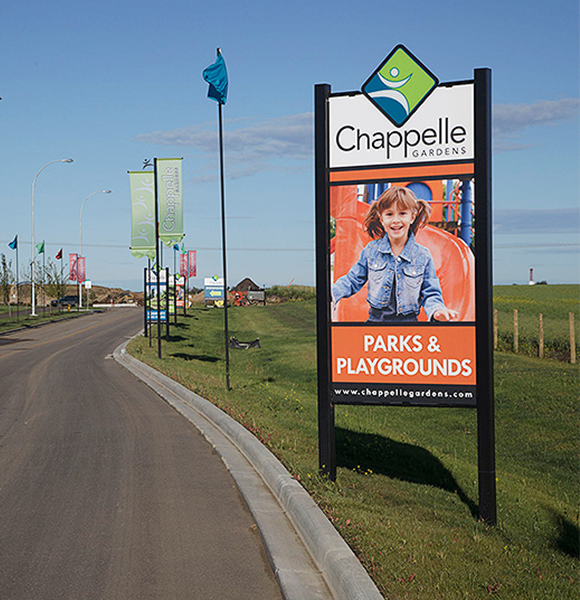
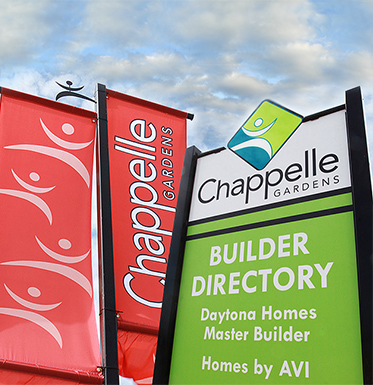
Comprehensive Planning
When planning your sign program, it’s important to spend plenty of time within the community and driving the different roads to understand the user journey within the space. Identify potential bottlenecks and areas of confusion to create an effective signage strategy. Using virtual maps such as Google Maps is a great way to visualize and map out the different locations signs should be.
User-Centered Design
Be sure to craft the wayfinding program with the end user in mind. You know your way around the community and how to get to and from your show home parade, but a potential home buyer does not. Consider their needs, behaviors, and preferences and ensure that your signage is intuitive and useful for your target audience, not someone who has been to the community hundreds of times.
A good tip is to have someone who doesn’t work within your community to review your wayfinding signage. If they find the signs easy to follow you’re golden!
Collaborative Approach
This approach works with our above tip. If you’re looking to build a successful community signage program, make sure you collaborate with a variety of stakeholders and users. As you’re developing a signage program be sure to have multiple people with different backgrounds review the program to make sure it makes sense. It’s also important to work with your printer and signage team to ensure where you want your signage to go is feasible. A street corner may be the perfect spot for a sign, but if there are too many other signs around the area, underground power lines, or natural features like trees and bushes, you may not be able to place signage there.
Don’t Forget the City
Wayfinding signage on major roadways may require permission from the City and permits. If you’re looking to create a comprehensive wayfinding program, don’t forget your permits! The City of Edmonton also has a showhome wayfinding program that allows you to print and place signage on major roadways, these signs can be incredibly helpful for potential buyers. We also suggest pole banners along major roadways for brand recognition.
Scheduled Maintenance
A key aspect of a successful wayfinding program is scheduled maintenance. Alberta weather is harsh and can significantly damage your signage with snow, wind, ice, hail, and even sun bleaching. Other factors can also damage your signage such as graffiti and vandalism or vehicles and snow plows. We recommend touring your community for a signage audit at least twice a year to ensure your program is properly maintained.
The Benefits of Cohesive Signage
If you have a properly maintained and executed wayfinding program, it can have a ton of benefits!
- Reduced stress or frustration for visitors
- Enhanced user experience
- Improved efficiency
- Brand recognition
- Increased showhome visitors

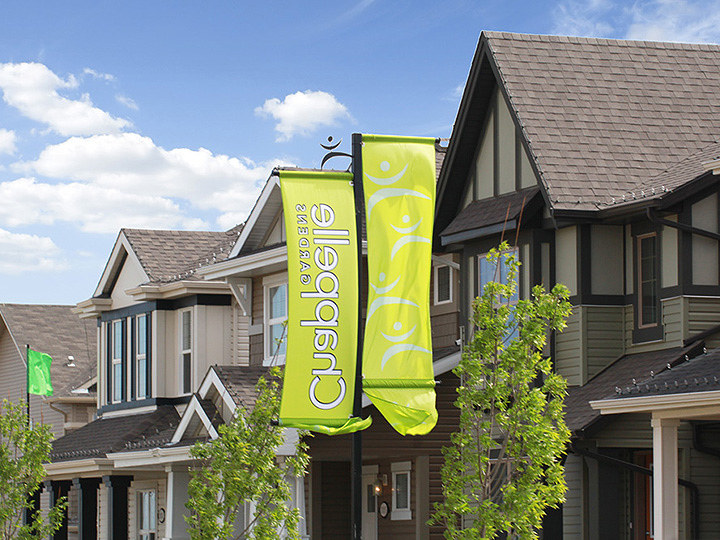
Well-designed wayfinding signage reduces anxiety and frustration among visitors who might otherwise struggle to find their way. A seamless navigation experience creates a positive impression and improves overall user satisfaction. Efficient wayfinding reduces the time visitors spend searching for directions and helps them head straight to your showhomes. When your signage is designed using your brand guidelines, users not only know for certain they’re in the right place, but they also will recognize your ads and branding elsewhere. Effective wayfinding will help potential homebuyers find your showhomes, so it’s incredible important that you ensure they are easily found.
How Much Does Community Wayfinding Signage Cost?
Determining the cost of community signage can vary widely based on factors such as the size of the area, the complexity of the design, the materials used, and any additional technology integration. Four by eight signs can cost a few hundred dollars at first, but it’s important to note that frames can be reused and reprinted for many years. It’s important to view wayfinding signage as an investment in improving user experience and reducing operational inefficiencies.
Let CSG Handle Your Wayfinding
Effective wayfinding signage is more than just a collection of signs – it’s a strategic and user-centered approach to navigation that considers architecture, design,and human behavior. By implementing a cohesive wayfinding program, spaces can create a more welcoming and efficient environment for visitors, leading to improved experiences in communities and more visitors for your showhome.
CSG has been designing and executing wayfinding programs for almost four decades! Let our experienced team plan your wayfinding program, design your signage, and handle maintenance! With CSG on your team, you’ll have beautiful signs arranged in a way to drive sales and the peace of mind that we have it handled!

